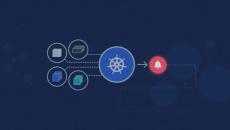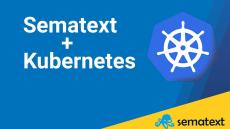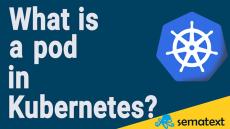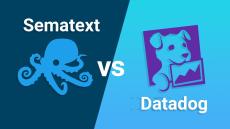|
By Marko Bonaći
In vino veritas, right? During a recent team gathering in Kraków, Poland, and after several yummy bottles of țuică, vișinată, żubrówka, diluted with some beer, the truth came out – even though we run Logsene, a log management service that you can think of as hosted ELK Stack, some of us still ssh into machines and grep logs! Whaaaaat!? What happened to eating our own dog food!?
|
By Sematext
Imagine you’re a detective trying to solve a crime, but all the evidence is invisible. Sounds impossible, right? That’s exactly what it’s like trying to debug a Java application without proper logging. Java logging is your magnifying glass, your fingerprint kit, and your trusty notepad all rolled into one. It’s the unsung hero that helps you understand what’s going on under the hood of your application. But logging isn’t just about catching bugs.
|
By fulya.uluturk
Imagine waking up to a critical system failure that has brought your business operations to a standstill. Panic sets in as you scramble to understand what went wrong. You sift through various error messages, desperately trying to pinpoint the issue.
|
By Hasan Wajahat
Websites are no longer static pages. They’re dynamic, transaction-heavy ecosystems where every click, form submission, and login matters. Whether you’re in e-commerce, SaaS, or finance, transaction failures can lead to revenue loss, frustrated customers, and even damage to your brand. That’s where web transaction monitoring tools come in — a critical component to make sure every interaction goes smoothly.
|
By Costas Pipilas
It’s 2 AM, and your phone buzzes with an urgent alert—your primary server application is down, and users are flooding the support channels with complaints. As you dive into the logs, the cause is elusive, buried somewhere in the sea of system events. Is it a rogue service eating up memory? A failing disk? Or a network bottleneck? Without powerful Windows monitoring tools, you’re left troubleshooting in the dark.
|
By fulya.uluturk
Ever found yourself drowning in a sea of log data, struggling to make sense of the overwhelming noise? Or perhaps faced a major system breakdown, only to find that your logs didn’t provide the answers you needed, leaving you in the dark? Effective logging is a critical yet often overlooked aspect of software development and operations, highlighting why logging is important – it’s the foundation upon which observability, troubleshooting, and system maintenance are built.
|
By fulya.uluturk
Logs act as silent sentinels, recording every whisper of your application’s activity. They are invaluable chronicles illuminating system behavior, diagnosing issues, and providing crucial insights into your application’s health. However, the true power of logs lies not just in their existence, but in how they are formatted. Log formatting is pivotal in transforming these raw data streams into actionable intelligence.
|
By Costas Pipilas
Running a Kubernetes cluster includes keeping an eye on it to make sure your apps and services are healthy. You don’t want to be staring at a bunch of Kubernetes dashboards all day, though. You want to set up kubernetes alerting with appropriate alerts instead, right? With k8s alerts, you will spot problems quickly in your Kubernetes cluster and hopefully fix them quickly as well. But what should you alert on? Here are the top 10 most important alerts you should set up for your Kubernetes cluster.
|
By Costas Pipilas
Launching a mobile App is no walk in the park, especially when it comes to your App’s store position and ratings. One of the trickiest parts is maintaining a good App store rating. An App’s store ratings are the key to its success. If you’re serious about your App succeeding in an oversaturated market, it is vital to implement strategies to both increase and maintain your App’s store ratings.
|
By Costas Pipilas
In the world of modern business, data drives decision-making. Every interaction, every transaction, and every click generates a series of data in the form of logs. These logs, often seen as plain text records, have the potential to unlock valuable business insights when analyzed correctly. In How to Create Log-Based Metrics to Improve Application Observability, we described the process of creating log-based metrics to improve application observability using Sematext Cloud.
|
By Sematext
Sematext Cloud's Fleet and Discovery makes managing agent installations and setting up service and log monitoring a super simple task. It lets you see, troubleshoot and manage each agent, use logs for diagnostics, and set up which services or logs you want to be monitored. Don't miss out on the opportunity to streamline your monitoring workflow and ensure the optimal performance of your technology stack.
|
By Sematext
🚀 Looking for a monitoring solution for your Kubernetes clusters? In this step-by-step guide, we will have Sematext monitoring your cluster in under 3 minutes! 🌐 Whether you're navigating the cloud or managing local deployments, this quick and easy setup unlocks the power of full-stack monitoring, ensuring your system's health is at your fingertips. In this concise tutorial, we will learn how to set up customized alerts to stay ahead of potential issues, effortlessly monitor your infrastructure's performance, and establish centralized logging for your Kubernetes environment. 📊💡
|
By Sematext
In this video, we will discuss what log levels are, how to use them in your application, and how to monitor your logs with Sematext. We break down the intricacies of log levels, guiding you through their significance and practical implementation. Elevate your DevOps game with insights on proactive issue detection and rapid problem resolution. With a centralized logging solution like Sematext Cloud, you can enhance collaboration, minimize downtime, and boost overall system performance.
|
By Sematext
In this short clip, we look at what a pod is and the basic architecture of Kubernetes. To learn more, check out these resources: Chapters.
|
By Sematext
Welcome to our Sematext vs. Datadog pricing comparison.
|
By Sematext
In this talk, Radu will delve into the world of Elasticsearch and OpenSearch within Kubernetes. In this informative snippet, we uncover the best practices for deploying, managing, and optimizing these powerful search and analytics engines in your Kubernetes environment. Whether you're a seasoned developer, a DevOps enthusiast, or a data-driven professional, this presentation offers invaluable insights that will enhance your Elasticsearch and OpenSearch deployment strategies.
|
By Sematext
Ready to dive into the world of Kubernetes? Join us in this beginner-friendly tutorial where we break down Kubernetes infrastructure, explore its fundamental components, and understand how it all fits together at a high level. Whether you're a developer, sysadmin, or just curious about Kubernetes, this video has you covered.
|
By Sematext
🚀 Dive into the world of Elasticsearch performance with our expert at Sematext! In this insightful conference talk, we explore the crucial differences between Doc Values and Field Data, shedding light on the best practices for optimizing your Elasticsearch clusters. Discover how the choice between Doc Values and Field Data can significantly impact your Elasticsearch queries, indexing, and overall system efficiency. Gain the knowledge and insights to supercharge your Elasticsearch deployments.
|
By Sematext
🚀 Elevate your OpenSearch game with Sematext! 🚀 Ready to excel in OpenSearch? Sematext offers top-tier Consulting, Training, and Production Support services, finely tuned to empower you with expertise in Opensearch's most critical aspects. Explore our comprehensive suite of services, meticulously designed to bolster your OpenSearch journey.
|
By Sematext
Monitoring Elasticsearch metrics is absolutely essential! Monitoring gives you information about the functionality, overall condition, and performance of your Elasticsearch cluster.
|
By Sematext
If you manage Elasticsearch clusters you'll find this cheat sheet created by Sematext Elasticsearch experts very handy. In it you will find a comprehensive list of copy-paste curl snippets for allocation, caches, segment merges, performance troubleshooting and quite a bit more. Enjoy and share!
|
By Sematext
The Cloud Native movement and migration of applications to microservice architectures require general visibility and observability into software behavior. OpenTracing aims to offer a consistent, unified, and tracer-agnostic instrumentation API for a wide range of frameworks, platforms and programming languages.
|
By Sematext
This Elasticsearch Developer Cheat Sheet provides a comprehensive list of key Elasticsearch operations every developer needs - index creation, deletion, mapping manipulation, indexing API, ingestion API, querying, aggregations, document relations (nested and parent child) and more! Enjoy and share!
|
By Sematext
In this reference architecture document, you will find out about all key Docker metrics to watch. Following that, you will learn how to set up monitoring and logging for a Docker UCP cluster. Specifically, this e-book shows how to use Sematext Docker Agent to collect metrics, events and logs for all Docker hosts and containers. Enjoy and share!
|
By Sematext
Evaluating Elasticsearch for a future project or preparing to "go live"? This e-book is an introduction to the working principles of Elasticsearch, with a focus on performance monitoring and tuning of production operations. This guide helps close the gap in understanding between team members such as developers, operations and their team leader. Enjoy and share!
|
By Sematext
This Solr / SolrCloud Metrics API Cheat Sheet shows you how to access all the new Solr metrics - Jetty Metrics, JVM Metrics, Solr Node Metrics, Core OS metrics, etc. Print it. Copy-paste from it. Use it when troubleshooting Solr performance issues. Enjoy and share!
|
By Sematext
This Solr / SolrCloud Cheat Sheet shows you how to access all the new Solr features - Running Solr, Data Manipulation, Searching, Faceting, Streaming Aggregations, etc. Print it. Copy-paste from it. Use it when troubleshooting Solr performance issues. Enjoy and share!
|
By Sematext
Looking to replace Splunk or a similar commercial solution with Elasticsearch, Logstash, and Kibana (aka, "ELK stack" or "Elastic stack") or an alternative logging stack? In this eBook you'll find useful how-to instructions, screenshots, code, info about structured logging with rsyslog and Elasticsearch, and more. Enjoy and share!
|
By Sematext
This Kubernetes Cheat Sheet puts all key Kubernetes commands (think kubectl) at your fingertips. Organized in logical groups from resource management (e.g. creating or listing pods, services, daemons), viewing and finding resources, to monitoring and logging. Enjoy and share!
|
By Sematext
Evaluating docker for a future log management or monitoring project? This Docker cheat sheet covers all you need to know from creating and starting a container in one operation to executing commands in containers, Docker networks, Data cleanup and more. Enjoy and share!
- January 2025 (1)
- October 2024 (3)
- June 2024 (1)
- May 2024 (3)
- December 2023 (3)
- November 2023 (5)
- October 2023 (9)
- September 2023 (12)
- August 2023 (5)
- July 2023 (9)
- June 2023 (2)
- May 2023 (10)
- April 2023 (7)
- March 2023 (17)
- February 2023 (4)
- January 2023 (12)
- December 2022 (3)
- November 2022 (5)
- October 2022 (5)
- September 2022 (5)
- August 2022 (9)
- July 2022 (10)
- June 2022 (7)
- May 2022 (5)
- April 2022 (2)
- March 2022 (5)
- February 2022 (2)
- January 2022 (4)
- December 2021 (1)
- November 2021 (3)
- October 2021 (2)
- September 2021 (1)
- July 2021 (3)
- June 2021 (3)
- April 2021 (4)
- March 2021 (3)
- February 2021 (5)
- January 2021 (3)
- December 2020 (5)
- November 2020 (4)
- October 2020 (1)
- September 2020 (4)
- August 2020 (3)
- July 2020 (1)
- June 2020 (7)
- May 2020 (1)
- April 2020 (3)
- March 2020 (1)
- February 2020 (1)
- January 2020 (6)
- December 2019 (3)
- November 2019 (1)
- October 2019 (1)
- September 2019 (2)
- August 2019 (2)
- July 2019 (3)
- June 2019 (3)
- May 2019 (6)
- April 2019 (10)
- March 2019 (9)
- February 2019 (5)
- January 2019 (4)
- December 2018 (5)
- November 2018 (7)
- October 2018 (8)
- September 2018 (6)
- August 2018 (2)
- July 2018 (3)
- June 2018 (3)
- May 2018 (4)
- April 2018 (1)
- February 2018 (1)
- October 2017 (2)
- May 2017 (1)
- February 2017 (1)
- January 2016 (1)
- December 2015 (2)
- November 2015 (2)
Sematext Cloud is an all-in-one observability solution for modern-day software-based companies that provides key insights into front-end and back-end performance. Sematext encompasses infrastructure, real user & synthetic monitoring, transaction tracing, and log management. Sematext gives businesses full-stack visibility by exposing key performance issues quickly and easily through a single Cloud or On-Premise solution.






















